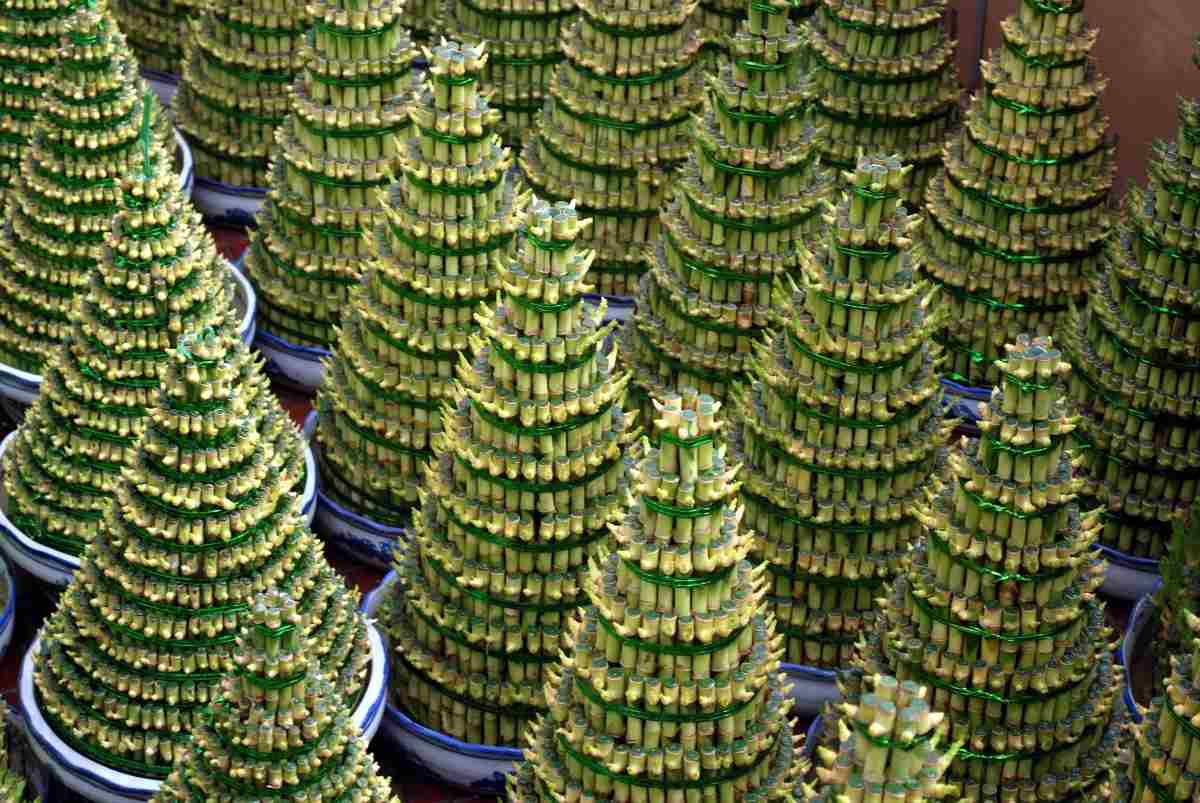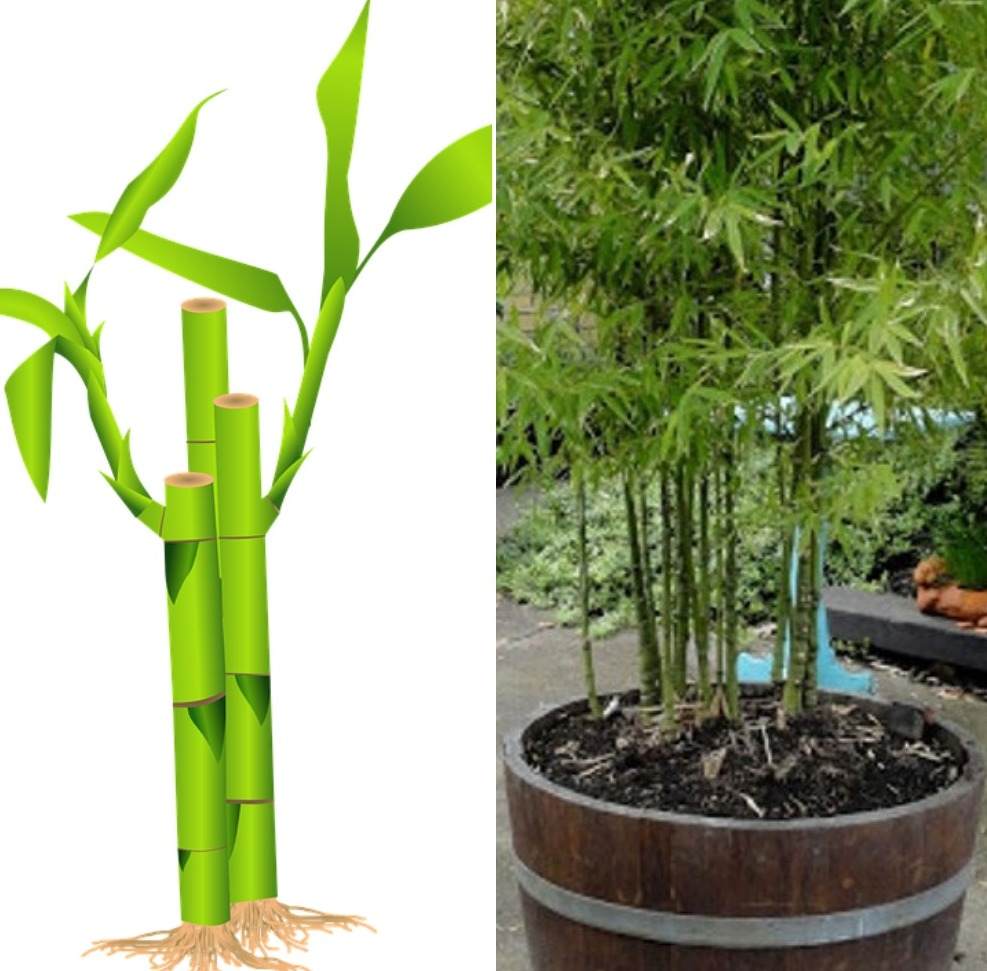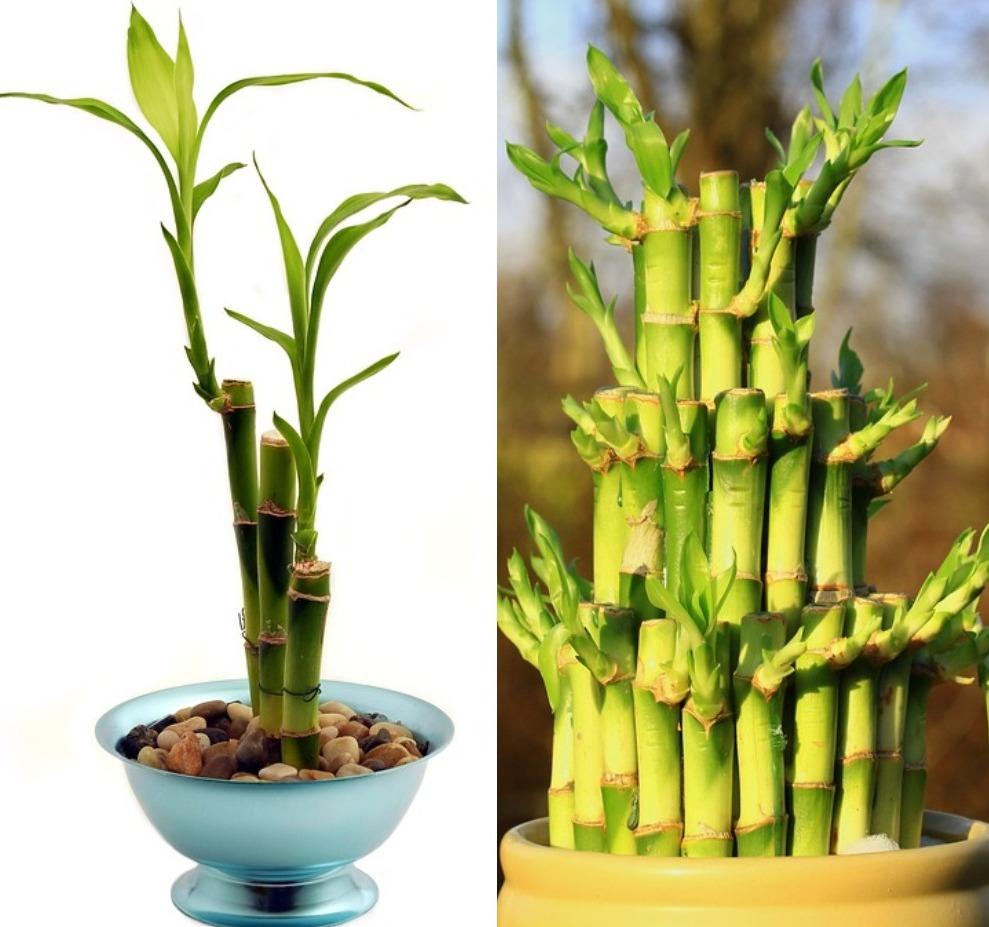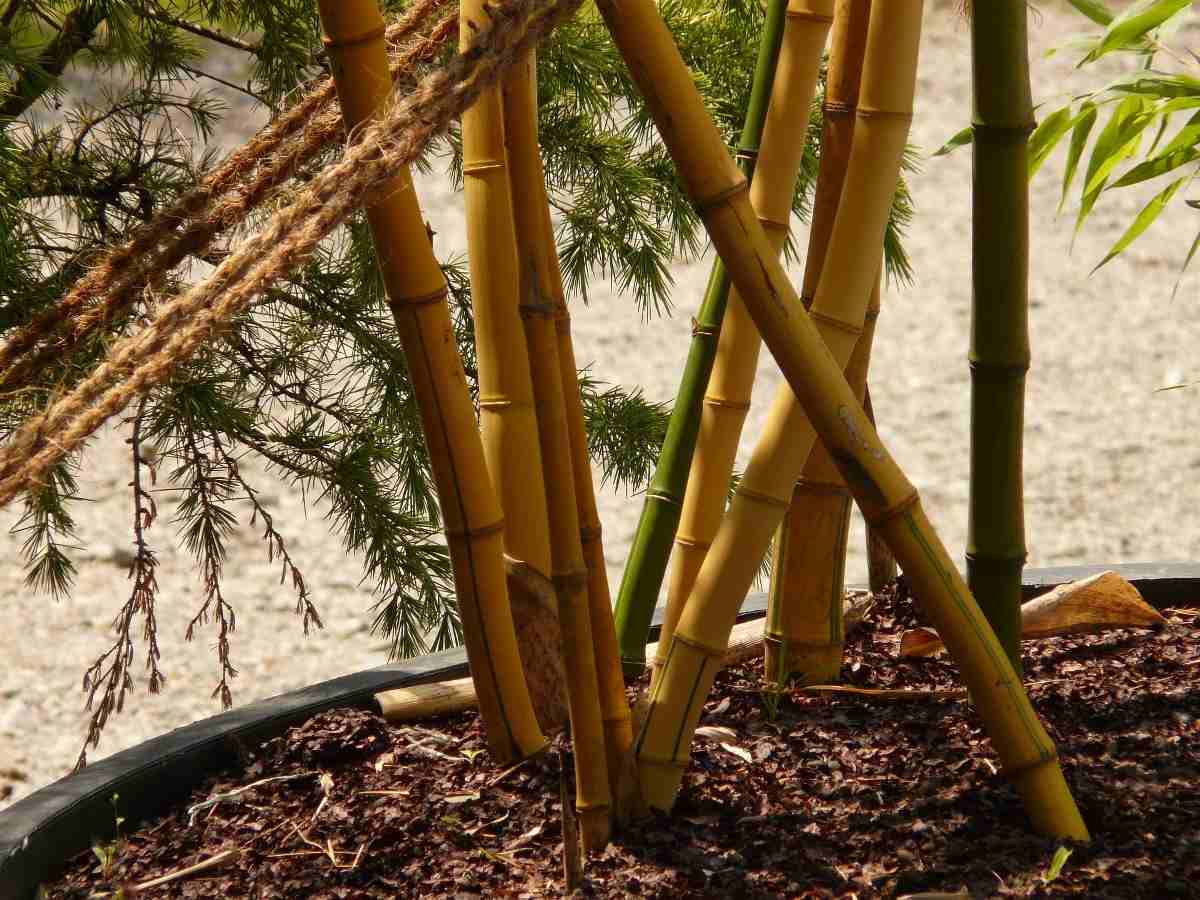Growing Bamboo Plants in Containers: A bamboo plant is a form of grass, though with a woody stem (culm). The bamboo plant is a fast-growing woody grass. Bamboo is important for construction, fencing, basketry, and many other uses. Bamboo plants are very desirable garden plants. They can make large clumps that are ideal as focal points or adding structure to borders. They can look unsightly if left to grow unhindered, and could become invasive. But keeping plants under control and attractive is easy with simple routine maintenance. In this article we also discussed below topics;
- Bamboo plant growing conditions
- Repot bamboo plant
- Can you overwater bamboo
- Stop bamboo from spreading
- Does cutting bamboo make it grow faster
- Does vinegar kill bamboo
- Take care of a dying bamboo plant
- How long do bamboo plants live
The following information may be applied to growing bamboo trees at home, growing bamboo plants in pots, growing bamboo plants on terrace, bamboo planting instructions in containers, growing bamboo plants in backyards, and growing bamboo plants indoors.
A step by step guide to growing bamboo plants in containers
A bamboo plant grown in beautiful ornamental pots or containers can look quite stunning. The combination of sizes, textures, colors, and shapes to go with bamboo is limitless. Growing bamboo in pots gives flexibility in maneuvering in the garden, patio or balcony. As the pot itself is a barrier, there is no need to be concerned with bamboo taking over the garden. Because bamboo achieves tall heights in small growing spaces, it is very ideal for those balconies or patios with tight spaces. However, bamboo care and maintenance can potentially be more involved depending on the species and pot sizes chosen.

You can also apply this information for growing bamboo indoors, growing bamboo in polyhouse, growing bamboo in shade, growing bamboo in outdoors, growing bamboo in pots, growing bamboo from cuttings, growing bamboo from seeds, growing bamboo from rhizomes, growing bamboo from shoots, growing bamboo from roots, and growing bamboo from stalks.
Size of container for growing bamboo plants
The bigger the container is the better. If you are planning to use planter boxes, 18×18 inches and 18 inches deep is the smallest you must go. The bamboo plant can be grown in smaller pots temporarily. If you are planting bamboo indoors in smaller pots, keep in mind that you will have to divide the bamboo fairly frequently to keep them healthy, 1 to 2 years. Also keep in mind that bamboo plants can blow over fairly easily, so avoid vase-shaped containers and use caution when placing a tall bamboo in a windy area.
The main factor that will determine the container size is the size of a specific bamboo plant. Though, the general rule is the bigger the better. Bamboo plants love space for their rhizomes and roots to spread. For the smallest bamboo varieties, you must not get a container that is smaller than 18×18 inches and at least 18 inches deep.
You should not miss the Growing Sweet Potato in Terrace in Pots.
Bamboo rhizomes (the part that spreads) tend to grow fairly shallow up to 12 inches deep. If you are planting bamboo in fairly small pots, make sure to remember to divide and replant the plant at least once every 2 years.
Choosing a bamboo plants for your containers
Choosing a bamboo for your container is quite similar to choosing a bamboo plant for your garden. You will want to know the amount of sunlight or shade your desired location will get. Most importantly, select a bamboo that is cold hardy enough for your location. The bamboo plant species section will list the hardiness, light tolerance, and growth characteristics.

Running bamboo plants will generally give the best height. Clumping bamboos do not grow as aggressively and generally last much longer in pots before they get root bound and need repotting. Normally, most clumping bamboo will not achieve the heights that a running bamboo would in a similar-sized container.
Choosing a good container bamboo plant
While there are more than 100 varieties of bamboo plants, some are suitable for container growing than others. When bamboo is grown in containers, even the largest of bamboo varieties will not reach their full growth potential as roots and rhizomes are constricted. When choosing a pot for bamboo, always select something that is low profile or squats lower to the ground. Ideally, the pot must be wider than it is deep. Because the bamboo plant is tall, it is easier for the wind to tip it over in a taller or light pot. Putting gravel or rocks at the bottom of a pot makes it bottom heavy and will less likely be blown over.
Some varieties of bamboo
However, some bamboo varieties have proven better for container growing than other varieties.
Sea breeze
Sea breeze bamboo plants can reach a maximum height of 35 feet tall when planted in the ground with open space. Their culms reach a 2 and a half-inch diameter, and they can withstand temperatures down to 20°F.
Sea breeze plant is one of the most salt-tolerant bamboo plants that there is. The plant grows into tight clumps with fine-grained wood. Sea breeze bamboo plant is considered one of the absolute best choices for a fast privacy screen or hedge due to its thick lateral foliage and upright growth.
When planted in a large, well-drained, and slightly insulated container, they can easily be maintained to stay at any height you select with a once annual hedge trimming. And they even make good standalone specimens, whether potted or not.
Multiplex Hedge Bamboo
Multiplex Hedge Bamboo plant can reach maximum heights of 15 feet when planted in open spaces; though, when planted in containers, they are easily kept at more maintainable heights. There are several branches down the culm’s base on each node, and when grown in containers they have been known to reach about 8 feet high. Cold tolerant down to 18 degrees, this little bamboo makes a great choice for starting your bamboo garden or growing a green screen.
Buddha Belly Bamboo
Buddha belly bamboo is also known as Bambusa Ventricosa, this clumping bamboo thrives in full sun to partial shade. With a maximum height that reaches 20 feet tall, this bamboo is known for staying even smaller when kept in a container. While it is popular as a small indoor plant or bonsai, it is highly versatile and adaptable to most conditions. With special care, it can easily be restricted in a container. Also, caretakers can artfully starve this bamboo plant for water to make it ‘belly out’.
You may also like the Hydroponic Perlite Growing Medium.
Buddha Belly Bamboo plant can adapt to nearly any lighting conditions and can withstand temperatures as low as 15 degrees Fahrenheit. This bamboo plant is known for requiring more water than most other types of bamboo, but it is one of the absolute best choices for indoor and outdoor container growing.
Considerations for growing bamboo plants in containers
It is very important to note the weedy or invasive tendencies of most bamboo varieties. Without proper precautions and containment during planting, they simply grow out of control. The bamboo plant grows and spreads rapidly through an underground rhizome, with each cane-like sprout being a part of the same plant. This rhizome is capable of extending far beyond the area intended, so containers or underground barriers are recommended for keeping bamboo out of unwanted areas.

To prevent a running bamboo plant from spreading, a “rhizome barrier” is essential. A barrier 2 or 3 feet deep is effective. A barrier does not stop a running rhizome and it only deflects it.
Vinegar works well as a natural herbicide because it’s acidic. Herbicides containing acetic acid, or vinegar in a stronger concentration, will kill the bamboo plant. Salt is not effective in killing the bamboo plant.
Potting soil for growing bamboo plants in containers
Ensure that quality, well-draining potting soil is chosen for growing bamboo. Premium soils developed specifically for growing plants in pots will contain ingredients that will assist with water retention, and sustain plant nutrients.
Fill with well-draining soil – Bamboo needs soil with light to moderate density, but able to hold moisture. You can use a standard potting mix, or make your own from about ⅓ loam, ⅓ perlite (or washed sand), and ⅓ peat moss (or well-rotted compost). Most bamboo plants can tolerate a wide range of well-draining soils, so the exact composition won’t make or break your plants.
You can use decent quality soil from the garden instead of potting soil. Avoid heavy clay soil, which drains poorly and is hard to improve. Bamboo tends to do best in slightly acidic soil, with a pH level between 5.5 and 6.5, but most species tolerate a pH value of up to 7.5. Bamboo grown in water can live one to two years. For a longer lifespan transfer bamboo to the soil where it can live for several years.
Nutrients for growing bamboo plants in containers
The bamboo plant is most hungry during the hot months when they are producing new stems. As they won’t have access to the nutrients in the ground, it is very important to feed the bamboo plant during this period. As the bamboo plant is a grass, it loves nitrogen, so choose a product that is high in this element (10 percent or more). To reduce the amount of time spent feeding the bamboo, the choice of a controlled release fertilizer for growing bamboo in containers is advisable. Choose one that has at least 6 to 8 months longevity and apply, as per the directions, at the start of spring each year.
Watering requirement for growing bamboo plants in containers
The bamboo plant looks the best if the soil in the pot remains moist. Regular watering is necessary to maintain a healthy plant, especially during the hot months. During this time the plant could require heavy watering every day. And the addition of a thick layer of mulch will assist greatly in preventing the soil from drying out. During the cold months, the bamboo plant goes into a relative dormancy, which means that it won’t require anywhere as much water.
Repotting bamboo
When a containerized bamboo gets root bound, it will need to be repotted into a bigger container or it can be divided and replenished with fresh new soil. If dividing, the best time is in fall or winter. Disturbing the root balls during the active growing seasons could potentially destroy the bamboo. Repotting into a larger pot could be done at any time of the year. Special care needs to be taken to not disturb the root ball if this is done during the spring or summer months.
Dividing and repotting bamboo plants may sound discouraging to some, but it is a fairly simple task and only needs to be done every 3 – 5 years (depending on species and size of the pot). One has to trim trees, branches and mow the lawn regularly.
Bamboo growth in pots
The size of the root ball is directly related to the size of the bamboo plant. The bigger the root ball, the bigger the bamboo plant. The smaller the root ball, the smaller the bamboo plant. As the growing area in pots is limited, the growth potential of bamboo is also limited. This translates too much shorter bamboos with thinner canes when grown in pots. Bamboo plants grown in pots will never reach the sizes of the same species grown in the ground. If tall and thick canes are the objective, then getting the biggest possible pot will give the best potential for size.
Incase if you miss this: Tomato Plant Spacing in Containers.
Care in growing bamboo plants in containers
Other than root space, caring for a bamboo plant in pots is easy. The bamboo plant needs plenty of water and good drainage. In the winter, the plant roots are at risk of cold. Protect them by wrapping the pot in mulching heavily. If you have particularly cold winters, it might be safest and easiest to bring your container grown bamboo plant indoors. Keep the plants at 40-50 F (4-10 C.) and give them plenty of light until outdoor temperatures rise again.
Reason for bamboo plants turning yellow
Newly planted bamboo seedlings need protection from the sun on hot days, as well as during the mid- to late afternoon when the sun is at its strongest. Providing shade is particularly important for bamboo varieties that require partial shade; otherwise, you risk damaging newly planted bamboo seedlings.
In a mild Mediterranean climate, protection from the sun on hot days is less crucial than in hot or arid climates, where scorching and moisture loss occur in temperatures upwards of 100F. Some people will also put their bamboo in water to help them deal better with warmer climates.
Maintenance of potted bamboo
To keep the bamboo looking fresh in their pots, the older stems can be cut away at the base and removed. This will put less demand on the plant as it doesn’t have to work as hard to keep each stem healthy and can assign energy towards growing new shoots. Even the more delicate bamboo plant varieties will eventually fill out their containers. This will take years, but it may need to be removed from its pot and re-potted or divided to create a smaller plant.

Container bamboo plants do require a little bit more maintenance than the ones grown in the ground. They are less hardy in containers and become root-bound if not divided and repotted in time. Also, environmental stress affects potted bamboo plants more than in-ground plants. Though, if you make sure to meet their needs, you can have a thriving bamboo plant almost anywhere, whether in container or not. So let`s start by remembering the basic things any potted bamboo needs to have to be healthy that means enough space, drainage, and insulation.
If you have taken care of these things when you are initially planting bamboo in the containers, then after that maintaining a potted bamboo requires little work. In the first year after the first potting bamboo plant, you must irrigate or ensure that bamboo is receiving a generous amount of water. While in-ground bamboos with no fertilizer it is a little different for the potted ones. You must give your plants a yearly, slow-release, high nitrogen fertilizer so that your bamboos are receiving a steady diet of nutrients.
Depending on how much space you have given to bamboo plants to spread, you should repot them every 2 – 5 years. This varies a lot depending on the species and container sizes but you will probably be able to tell visually when it`s time to give your plants more space.
That’s all folks about growing veduru tree or growing bamboo in containers. You may also check the Hydroponic Tomato Farming.